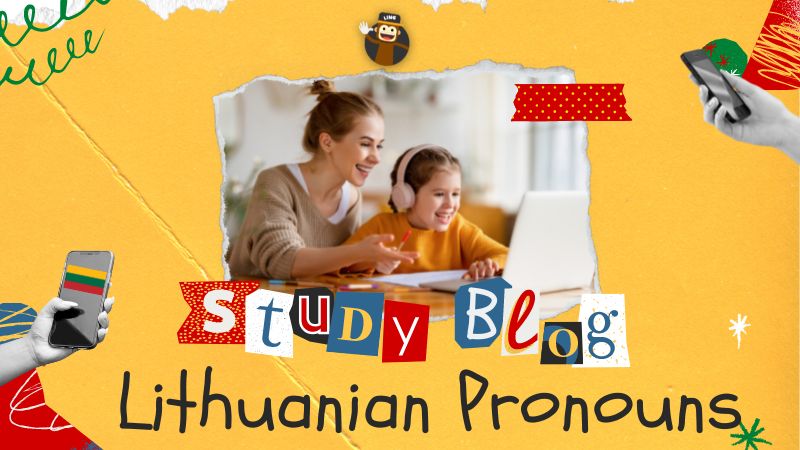Aren’t you sick of using the names of people just because you don’t know any better ways to address them? You must always be wondering if this problem will ever be resolved. Worry no more because this blog post brings an answer to all these questions and a perfect solution for this problem. You will learn all the types of Lithuanian pronouns, along with their cases and countless examples. Without further ado, let’s get started.
Lithuanian Grammar
Lithuanian is a gendered proto-language, a Baltic (Indo-European) language closely related to the Slavic languages. It has Sanskrit, Greek, and Latin vocabulary and is an unchanged language. The core of this language is quaint yet classical.
Every language has its grammatical concepts, without which it becomes incoherent. It makes us communicate and understand the basics. If you ever learn a language other than your native one, you must first grasp its grammatical portion to learn it quickly and accurately.
The Lithuanian grammar rules are slightly different from the English language. It has no articles to distinguish between common and proper nouns and many more such varied rules. In the same way, its rules for pronouns are different too, and you will just learn about that.
Lithuanian Pronouns
The word “Įvardžiai” is used as a “pronoun” in the Lithuanian language. Pronouns are words used instead of a noun to avoid repetition. They can also help differentiate between formal and informal conversations in this language.
The genders of nouns are masculine and feminine in the Lithuanian language, and consequently, the pronouns are also different for masculine nouns and feminine forms.
In Lithuania, great respect and admiration are shown to everyone through the language. For instance, “You” is said as “Tu” in Lithuanian vocabulary informally. While “You” is formally called “Jūs” in modern Lithuanian.
Vigilance is required when talking to strangers and elders. So when we speak about the complexity and nexus of this language, it is considered unnecessarily burdensome by the speakers who don’t have the same rules in their language. However, you should know these little details so that you don’t offend native speakers but rather get closer to them.
To learn about Lithuanian Pronouns, you need to understand all the types of Lithuanian pronouns, and here are all of them.
Personal Pronouns
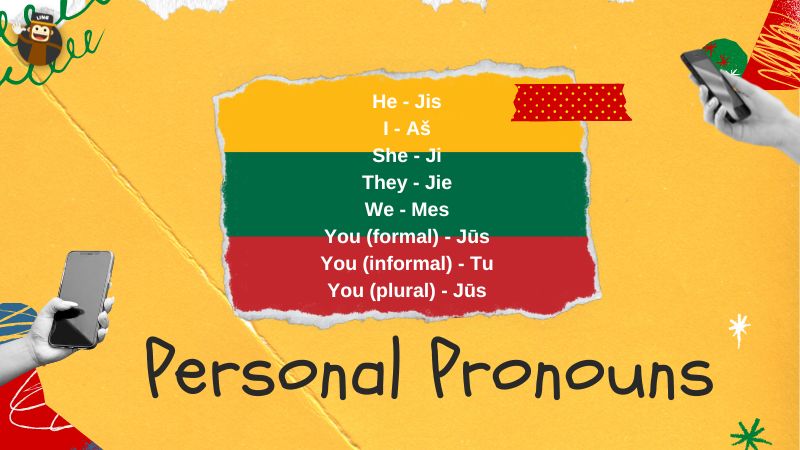
Personal pronouns refer to short words used as a substitute for the proper name of a person or thing etc. These relate to a person, gender, number, or case in grammar, and they distinguish the genders of nouns such as singular, plural, and all other dual nouns.
In English grammar, there are sets of personal pronouns like I, we, you, they, etc. Similarly, Lithuanian personal pronouns have specific locations for all singular and plural forms and other cases in sentences. They usually come at the start of a sentence in Lithuanian.
The corresponding personal pronoun (Aš) is used for I, (Tu) for you, (Jis) is used for he/it, and (Ji/Jos) ours is used for she/it in Lithuanian grammar. The word (Jie/jos) is used for them and (Juose) in the nominative case.
All these personal pronouns are used in daily life in the Lithuanian language and in the same form as reflexive pronouns. Here are some common examples regarding personal pronouns in Lithuanian:
| English | Lithuanian | English | Lithuanian |
| He | Jis | He did your homework | Jis atliko tavo namų darbus |
| I | Aš | I did not like her | Man ji nepatiko |
| She | Ji | She is very selfish | Ji labai savanaudiška |
| They | Jie | They have done a great job | Jie atliko puikų darbą |
| We | Mes | We miss you so much | Mes tavęs labai pasiilgome |
| You (formal) | Jūs | You all are beautiful | Jūs visos gražios |
| You (informal) | Tu | You love cats | Tu myli kates |
| You (plural) | Jūs | You all need to leave right now | Jūs visi turite išeiti iš karto |
It also uses anaphoric pronouns in third-person cases where singular and plural or masculine and feminine nouns are regarded as one person (it). The word “it” can be used for both genders nevertheless of any specification, like in English.
Possessive Pronouns
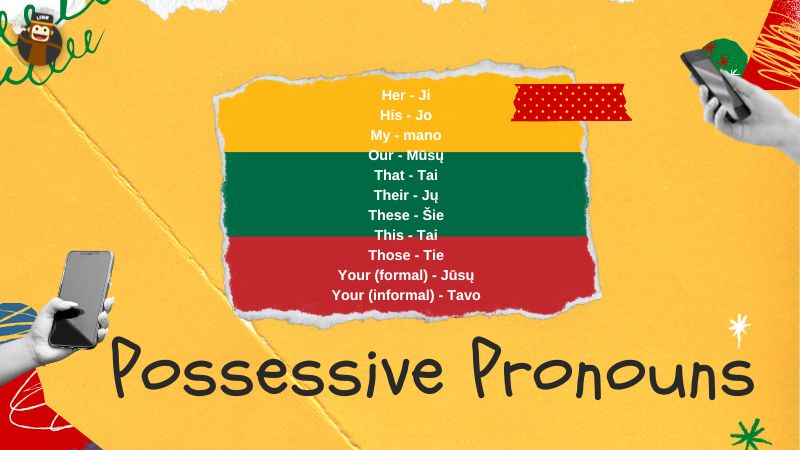
Like English possessive pronouns, Lithuanian Pronouns are also used to show possession and ownership. They are used to indicate the belonging of something to a person and avoid the repetition of a noun.
They are not specific to any number or case. In some cases, the gender is specified by using specific possessive pronouns, while in most cases, the gender of the personal pronoun is not specified.
For example, Tokie mano namai. (This is my house.)
In this example, the pronoun mano (my) shows that the house belongs to me.
Examples
| English | Lithuanian | English | Lithuanian |
| Her | Ji | She is in her class | Ji yra savo klasėje |
| His | Jo | He is in the bathroom | Jis yra vonioje |
| My | mano | My cat died last week | Mano katė mirė praėjusią savaitę |
| Our | Mūsų | Our mum cooks the best food | Mūsų mama gamina geriausią maistą |
| That | Tai | That is your chance | Tai jūsų šansas |
| Their | Jų | Their mother dies last week | Jų motina mirė praėjusią savaitę |
| These | Šie | These books need to be thrown outside | Šias knygas reikia išmesti į lauką |
| This | Tai | This is my house | Tai mano namai |
| Those | Tie | Those slippers are yours. | Tos šlepetės yra tavo. |
| Your (formal) | Jūsų | Your pant looks fabulous | Jūsų kelnės atrodo nuostabiai |
| Your (informal) | Tavo | You name is horrible | Tavo vardas baisus |
Reflexive Pronouns
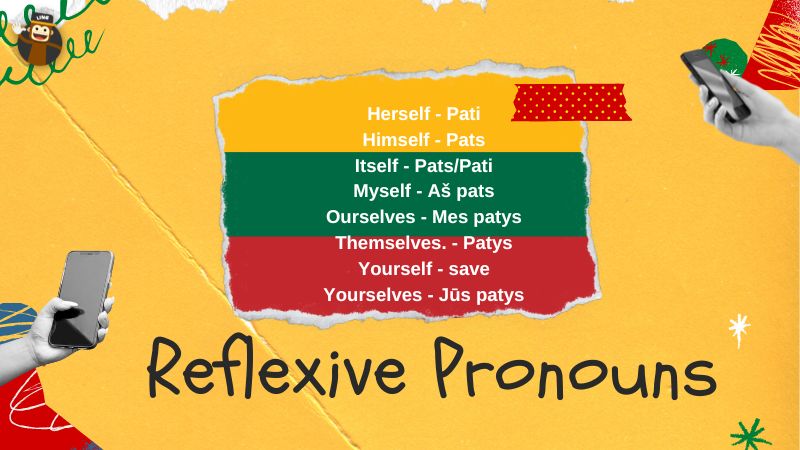
These are the pronouns that use specific words or nouns to reflect the action with the sentence’s verb. Like English grammar, Lithuanian reflexive pronouns are also used to relate the verb with the action being done.
They do not have any singular, plural, or other dual number cases. They are used in specific sentences. They also do not have nominative and vocative cases, but they are used in other cases, as shown below:
- Genitive (Savęs)
- Dative (Sau)
- Accusative (Save)
- Locative (Savyje)
- Instrumental (Savimi)
For example, Aš perku sau knyga. (I am buying myself a book.)
In this example, the word (myself) shows the reflex action with the verb.
Examples
| English | Lithuanian | English | Lithuanian |
| Herself | Pati | She did that herself | Ji pati tai padarė |
| Himself | Pats | He needs to do his work himself | Jis turi pats atlikti savo darbą |
| Itself | Pats/Pati | It has done that itself | Tai padarė pati |
| Myself | Aš pats | I want to go there myself | Aš pats noriu ten nuvykti |
| Ourselves | Mes patys | We need to clean up ourselves | Turime apsivalyti patys |
| Themselves. | Patys | They will do that themselves | Jie patys tai padarys |
| Yourself | Save | How about you try to save you yourself? | O kaip pabandytum save išgelbėti? |
| Yourselves | Jūs patys | Find peace yourselves | Raskite ramybę patys |
Indefinite Pronouns And Linking Words
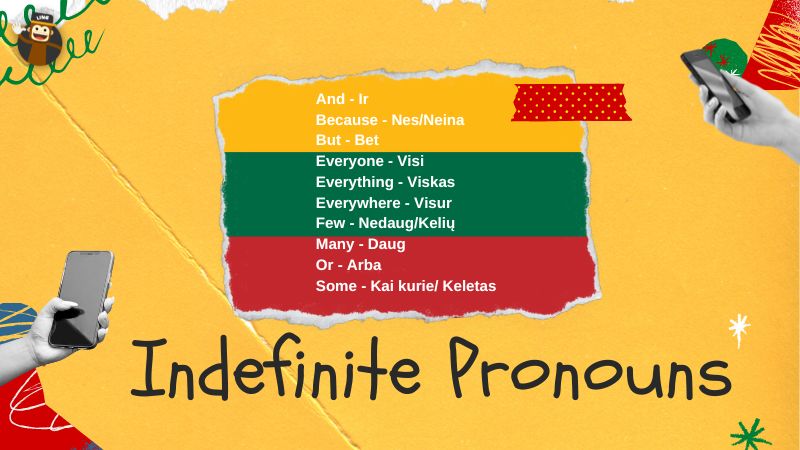
These are the forms of the pronouns in which we are not sure about the doer of the subject. It has the same dual forms as the other languages, which are one-word pronouns.
Examples
| English | Lithuanian | English | Lithuanian |
| And | Ir | He and she are going | Jis ir ji eina |
| Because | Nes/Neina | He is not going because of you | Jis neina dėl tavęs |
| But | Bet | I have to go but I can’t | Turiu eiti, bet negaliu |
| Everyone | Visi | Everyone is busy with their work | Visi užsiėmę savo darbu |
| Everything | Viskas | Everything is quite horrible | Viskas gana baisu |
| Everywhere | Visur | It’s beauty everywhere | Tai visur grožis |
| Few | Nedaug/Kelių | We need few compliments | Mums reikia kelių komplimentų |
| Many | Daug | You have many dresses | Turite daug suknelių |
| Or | Arba | Do you want coffee or tea? | Nori kavos ar arbatos? |
| Some | Kai kurie/ Keletas | Here are some of your students | Štai keletas jūsų mokinių |
Demonstrative Pronouns
These are the forms that point out the subject with one-word formation. As in English, there are two stages, like “this” or “that,” but it contains three major distinctive steps:
- Šitas (This)
- Tas (That)
- Anas (That, Far away)
The first pronoun is the speaker, the second is the near one, and the third is far from both, related to the concept of anaphoric pronouns. In short, it relates to the sentence’s number, gender, and case.
Examples
| English | Lithuanian | English | Lithuanian |
| Neither | Nei | Neither of the camels is mine | Nė vienas iš kupranugarių nėra mano |
| None | Nė vienas | None of these solutions are acceptable | Nė vienas iš šių sprendimų nėra priimtinas |
| Such | Toks | Such was his demeanor throughout the speech | Toks jo elgesys buvo per visą kalbą |
| That | Tai | That is the right way to go, actually | Tai iš tikrųjų yra teisingas kelias |
| These | Šie | These are some of my best expressions | Tai vieni geriausių mano posakių |
| This | Tai | This was his last wish | Tai buvo paskutinis jo noras |
| Those | Tie | Those are the shoes that you have always wanted | Tai batai, kurių visada norėjote |
Interrogative Pronouns
These pronouns are used for asking questions, the same as the grammatical concept of English. They are used with different verbs, prepositions, and other suitable adjectives.
Examples
| English | Lithuanian | English | Lithuanian |
| How? | Kaip? | How are you? | Kaip laikaisi? |
| What? | Ką?/Koks? | What is your name? | Koks tavo vardas? |
| When? | Kada? | When did you go there? | Kada tu ten nuėjai? |
| Where? | Kur? | Where are you? | Kur tu esi? |
| Which? | Kuris? | Which is your bag? | Kuris tavo krepšys? |
| Whom? | Kam?/Ką? | Whom do you love? | Ką tu myli? |
| Whose? | Kieno? | Whose sister are you? | Kieno tu sesuo? |
| Who? | Kas? | Who has done this? | Kas tai padarė? |
But like most Indo-European languages, Lithuanian grammar doesn’t have a specific difference between Who (Kas) and What (Ką?/Koks). They both can be used in replacement of each other or in standard forms.
In most cases, they can act like relative pronouns.
- Keliñtas (Which)
- Katras (Which of the two)
Negative Pronouns
These pronouns refer to the neglecting action in a sentence. In Lithuanian grammar, there are no such rules for these pronouns. Neglecting can be made simply by placing (-ne) with the sentence’s main verb.
It can be cleared by comparing the examples given below:
- Aš rašau (I am writing)
- Aš nerâsau (I am not writing)
There was no negative word in the first example, but the second sentence was completed by neglecting i.e., just putting the pronoun with the verb rašau (writing).
Examples
| English | Lithuanian | English | Lithuanian |
| No | Nr | He showed no interest in going with her. | Jis nerodė jokio susidomėjimo eiti su ja. |
| Nobody | Niekas | Nobody is in the alley at night. | Naktį alėjoje niekas nėra. |
| None | Nė vienas | None was in the dark. | Niekas nebuvo tamsoje. |
| Nothing | Nieko | The doctors did nothing to rescue the girl. | Gydytojai nieko nedarė, kad išgelbėtų mergaitę. |
| No one | Niekas | No one was there when I needed them the most. | Niekas nebuvo šalia, kai man jų labiausiai reikėjo. |
Attributive Pronouns
These are the pronouns used to describe a group, person, or another object as a whole unit.
In English grammar, the words all, each, every, everybody, both, etc., is used as attributive pronouns to show all subjects as a whole. Similarly, in the Lithuanian language, attributive pronouns are not used that much, but in most forms, they are used for numbers and the case of the sentence.
- Visi (Everybody, All)
- Kiekviena (Each)
- Tiek (Both)
- Visi kviečiami į vakarėlį. (Everybody is invited to the party.)
Pronoun Cases
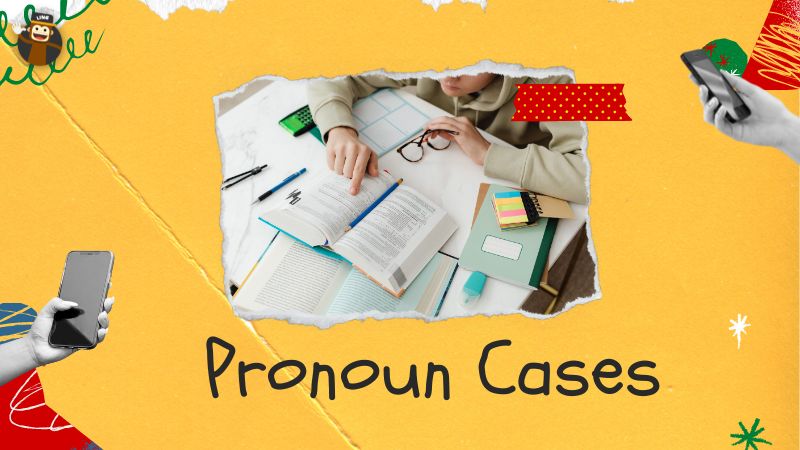
Lithuanian grammar is known for its severance in each case of gender, countability, etc. “Nes” is used in Lithuanian for “I,” showing the singularity of a person, and “Iš” is used for “We” to show the majority of the speakers.
It is a collection of nouns and noun clauses that explains the relation of nouns or pronouns with other words in the sentence. There are three pronoun cases in English grammar :
- The pronouns such as I, we, you, he, she, it, etc. are personal cases.
- Similarly, the pronouns such as me, us, you, him, her, etc. are objective cases.
- For the possessive case, the pronouns my, your, his, her, your, it’s there, our, etc. are used.
But in Lithuanian grammar, there are seven grammatical cases. Initially, while discovering the language, the scholars counted them to be ten in numbers, but later one point was modified to an adverb, and one vanished and is not used anymore.
Nominative (Vardininkas)
This case is mainly used to explain the subject part of a sentence and is like the personal case in English grammar.
For example, My mother is sick (Mano mama serga)
This case is used for gender, number, and other issues of Lithuanian grammar.
Genitive (Kilmininkas)
This case represents a sentence’s possession or relationship between words and reflexive verbs. The genitive singular, plural, and other forms are equivalent to English grammar.
For example, Jos knyga (Her book)
Here it shows possession that the (book) belongs to her, so it’s a Genitive case.
Accusative (Galininkas)
The accusative case (Galininkas) refers to the relationship between the subject and the direct object. It is also used with prepositions in Lithuanian grammar.
For example, Jis atsitrenkė automobilį. (He hit the car)
Here he is the subject, and the accusative case relates it to the direct object (the car).
Dative (Naudininkas)
This case is used for representing indirect objects and is opposite to the accusative case. It shows the relationship of indirect objects with the verbs.
For example, Ji nuvežė katę pas veterinarą (She took her cat to the vet)
Here, she is the subject, the cat is the direct object, while (the vet) is the indirect object shown by the dative case.
Instrumental (Įnagininkas)
This case refers to the process or means through which an action has been done. It explains how a pronoun has gained or accomplished its step. The subject or pronoun is used as an instrument or tool to show the action in the sentence.
It is indicated using words such as “by” and “with” along the objective.
For example, Jis kirviu nukirto medį. (He chopped down the tree with an axe.)
Locative (Vietininkas)
As the word suggests, locative (Vietininkas) relates to the location or time in the sentence.
For example, Ji guli ant sofos. (She is lying on the couch.)
Šiandien radau jį namuose. (I found him at the home today.)
Vocative (Šauksmininkas)
This case addresses someone, and the one word used for calling someone in a sentence relates to this case.
For example, George, ar ateisi į vakarėlį? (George, are you coming to the party?)
It has a specific form for singular nouns, but its plural form is identical to that of the nominative plural.
Wrapping Up

If you want to learn Lithuanian accurately with grammar understanding, you should practice them, pull an all-nighter sometimes, and take Lithuanian lessons every day. You can get a firm grip over grammar in no time if you show some consistency.
You can check our website and learn grammar by heart for further details. You should also check out country names and nationalities and say congratulations in Lithuanian.
Stay in touch with the Ling App to learn much more in an extremely fun and effective way. While learning on Ling App, you would not feel like studying something. Instead, you would be enjoying it, and that’s the purpose of life anyway.
What are you waiting for? Download the Ling App from Google Play Store or App Store and start learning the Lithuanian language.
